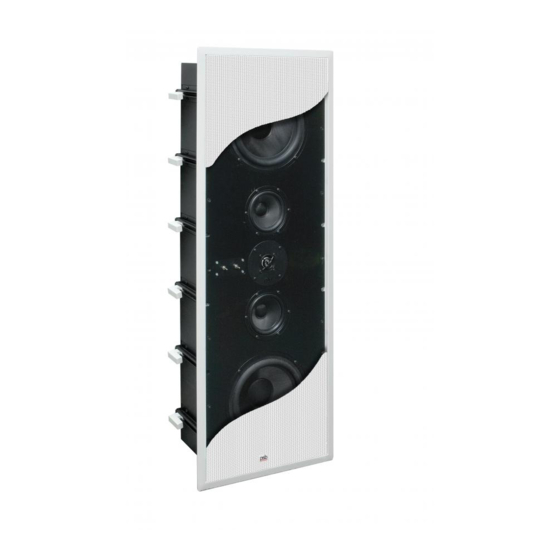Table of Contents
Advertisement
Quick Links
Advertisement
Table of Contents

Subscribe to Our Youtube Channel
Summary of Contents for PSB CustomSound CW800E
- Page 1 CustomSound series Owner’s Manual CW800E CW600E CWS10...
-
Page 2: Table Of Contents
CONTENTS Warranty Registration Unpacking III. Materials and Tools A. Required Tools B. Other Tools IV. Speaker Placement A. Listening Locations B. Speaker Locations C. You in Relation to the Speakers D. You in Relation to the Room Boundries E. Positioning Surround Speakers F. -
Page 3: Warranty Registration
II. UNPACKING The packing materials of your PSB speakers are designed to protect them from damage during shipping. Retain the packaging in case the need arises to transport the speakers in the future. -
Page 4: Speaker Placement
IV. SPEAKER PLACEMENT — MAXIMIZING YOUR ENJOYMENT Proper loudspeaker placement is an essential ingredient to getting the best sound from your high performance stereo, multi-channel audio or home theater system. The goal is to reproduce faithfully the audio soundtrack the movie director or music producer created without calling any attention to the speakers themselves. -
Page 5: You In Relation To The Speakers
Balance adjustment can compensate for some physical location difference between left and right. Time-delay adjustment of surround sound can compensate for some physical location difference between front and rear. With mono signals equidistant, symmetrical location is still desired to minimize balancing requirements. -
Page 6: Positioning Surround Speakers
E. Positioning Surround Speakers All PSB CustomSound Series speakers including the CW800E and CW600E are timbre matched (have similar tonal characteristics) for easy mix and match home theater system flexibility and ultimate performance. Most surround sound (that is sound that comes from the surround speakers, not the front speakers) is meant more to create greater depth and overall ambience than to localize effects as coming from a particular spot. -
Page 7: System & Supply
With tentative speaker locations determined, potential obstructions must be explored and the conflicts resolved: Structural; Mechanical—Electrical, Plumbing, and HVAC; and Furnishings. Note: The CW800E and CW600E have a large enclosure and must have a full (16” center) unobstructed stud bay with no other wiring or plumbing. -
Page 8: Installation
With further tightening it finally clamps the wall firmly. This clamping style gives firm clamping for freedom from rattles, and great convenience of installation. The CW800E has 16 of these clamping assemblies. The CW600E has 12. - Page 9 DO NOT OVERTIGHTEN. The system has been well designed to prevent stripping or damage from over tightening but PSB cannot be responsible for damage due to unreasonable force being used when mounting the system.
-
Page 10: Connections
Should it ever be necessary to remove the system from the wall, then unscrew each leg (counter clockwise) in turn. As you unscrew the screw head will lie flat in the frame until near the end of its travel, where the screw starts to rise. STOP AT THAT POINT . -
Page 11: Conventional Wiring
B. Conventional Wiring Connect speakers identically to your amplifier or receiver on each channel Red amp/receiver terminal to Red speaker terminal, Black to Black. This will ensure that the diaphragms of the speakers on both channels move forward and backward together (“in-phase”), rather than in opposition (“out-of-phase”). In- phase connection provides maximum clarity and bass, while out-of-phase connection results in frequency cancellations and produces thinner and less distinct sound—with less bass, vague vocal quality, and no solid center image. -
Page 12: Painting
XII. SETUP A. High and Mid Frequencies Switches We at PSB have spent great effort to make the frequency response of your in- wall system as flat and neutral as possible. Still, variations in the listening position, room acoustics and listener preferences can be well accommodated using a few chosen controls. -
Page 13: Listening-Balance, Range And Imaging
Decreasing high and mid frequencies increases relative bass response, while decreasing efficiency and sound power output. To modify the response, simply flip the baffle-mounted switch or switches to the alternate position—pressing the upper half gives the normal position - pressing the bottom half gives the decreased position as shown in the graphic of the adjacent label. -
Page 14: In Case Of Problems
See your dealer if you require service. PSB dealers are equipped to handle almost all problems. If you have moved since your purchase, the nearest authorized PSB dealer should be able to help you. -
Page 15: Specifications
XV. Specifications CW800E CW600E CWS10 Frequency Range Response On Axis @ 0° ±3dB 38-33,000Hz 45-33,000Hz 30-200Hz Sensitivity (with CWA-1) Anechoic Chamber 87dB 86dB 90dB Typical Listening Room 89dB 88dB 92dB Impedance Nominal 4 Ohms 6 Ohms 4 Ohms Input Power... - Page 16 PSB Speakers 633 Granite Court Pickering, Ontario L1W 3K1 CANADA www.psbspeakers.com 888-772-0000 (North America) 905-831-6555 (International) Fax: 905-837-6357 OM-CW-E, Rev B, 1106...














Need help?
Do you have a question about the CustomSound CW800E and is the answer not in the manual?
Questions and answers